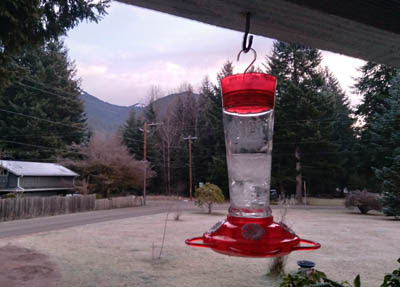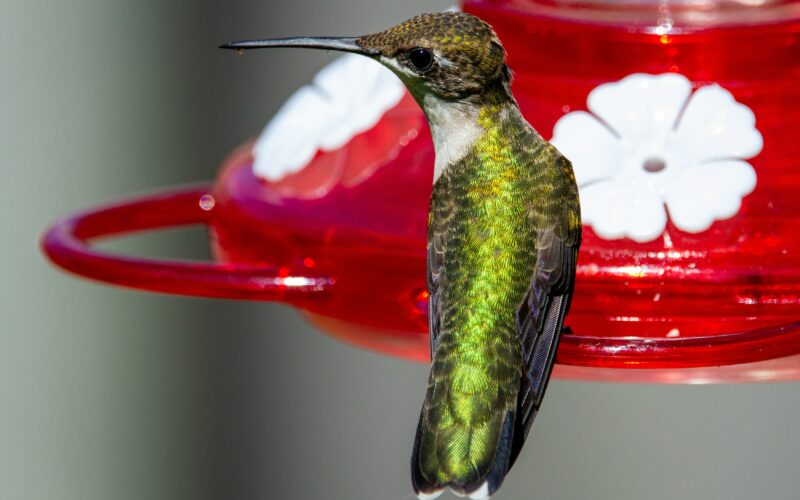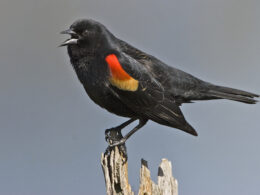Last Updated on January 9, 2024 by Greg Gillson
In some areas of the United States and Canada hummingbirds live year-round. Yes, even in some areas that occasionally freeze or have snow in winter.
For instance, Anna’s Hummingbirds are resident from British Columbia, Canada, south through Washington State, Oregon, California and Arizona. While winters are generally mild, freezing weather (and snow in the northern parts) may occur in winter, or as a surprise in spring.
A few Ruby-throated Hummingbirds may winter in the Southeast, on either on the Atlantic or Gulf coast lines. Winter may have some freezing weather and snow, especially northward and inland.
Other hummingbirds may live in winter in desert lands from southern California, across Arizona, to Texas. Overnight lows may reach to freezing. Rarely, a few days of freezing weather may occur.
It is important that during these times that hummingbird feeders be kept clean, full, and liquid!
But how can you keep the sugar water of your hummingbird nectar from freezing?
The simplest and best way to keep your hummingbird feeder from freezing is by bringing them indoors at night. Other ideas for keeping your hummingbird feeders warm include heating with incandescent light or wrapping with a pipe heating cable.
More ideas follow.
 |
| Oh no! My hummingbirds woke up to a frozen feeder! |
Dealing with frozen hummingbird feeders
There are a few ways to deal with frozen feeders. You can let them thaw out on their own. You can thaw them yourself. Or you can prevent them from freezing in the first place.
Ignore frozen hummingbird feeders
Perhaps the most common way to deal with frozen feeders is to ignore them.
If nighttime temperatures drop below freezing, but daytime temperatures rise to above freezing, then frozen hummingbird feeders will thaw out on their own during the day.
In fact, hummingbird nectar, with a ratio of one part sugar to 4 parts water, will remain liquid down to 27F (-2.8C).
Despite their diminutive size, hummingbirds are quite hardy and can handle freezing weather for a day or two. If your hummingbird feeder freezes overnight, your hummingbirds are likely to be just fine.
Prolonged freezing weather, though, requires some action on your part.
Thaw frozen hummingbird feeders
Recently, several days of snowy weather meant that my hummingbird feeders would freeze in a couple of hours.
What did I do? I brought the feeder in at night. Then I put it out first thing in the morning. The hummingbirds would have liked me to put it out sooner–they were buzzing and snapping around me as I hung it.
The feeder froze again before noon. So, I brought it in and let it thaw, before putting it out again for the afternoon feeding time (dusk).
Hummingbirds feed most actively at sunrise and again just before dark. Make sure they have liquid hummingbird nectar at these two critical times.

A warning about microwaving frozen hummingbird feeders
It might seem easy to stick smaller hummingbird feeders in the microwave. And it is–I tried it. But be careful. I microwaved for only 15 seconds at a time, for 45 seconds total, checking temperature between.
First, I removed the metal hanging hook. No metal should be placed in a microwave!
Second, I knew that the air trapped in the feeder would expand greatly when heated, pushing out the liquid. Fortunately, even though I had an inverted feeder style, it has a saucer at the bottom. Thus, the expanded air didn’t cause the nectar to be forced out and spill. I set an 8×8 inch Tupperware container under it, just in case.
Third, make sure it isn’t hot! You may burn yourself. Don’t microwave until the ice is completely gone. Leave some and it will cool any hot spots. Let the feeder water reach room temperature before putting it out for the hummingbirds again.
Don’t microwave your hummingbird feeder. Microwaving cold glass could cause it to crack, shatter or expel hot sugary steam. You may melt the plastic feeder parts. There, that’s my safety warning.
Switch out frozen feeders
This is probably the most common and safe way to keep hummingbird feeders thawed.
Purchase two feeders and switch them out every couple of hours during freezing weather.
Having two feeders in spring and summer will often bring far more hummingbirds to your backyard than just one feeder. So having two hummingbird feeders is reasonable. They aren’t expensive.
I really like the small 10 ounce More Birds Ruby hummingbird feeder. It is easy to clean and doesn’t leak or drip. Mine has lasted several years. It has endured baking San Diego summers and freezing Washington State winters (see opening photo).
Partially fill two hummingbird feeders with nectar. Put out one feeder at a time. When the first freezes, switch it out with one that has warm liquid from inside your home. Check back a few hours later. If necessary, switch them out again. Keep this up during the cold snap.
Remember, though, keep the hummingbird nectar fresh. Just as in summer, regularly empty and clean your feeders. Don’t top off feeders. Always clean when refilling.
Hang your hummingbird feeder near the porch light
You know, this used to work quite well.
Hang your feeder on a hook near (but not touching!) a porch light.
It was a little easier when the light was in the porch ceiling. Then you could suspend the feeder from a ceiling hook or even just a nail.
For a wall mounted porch light, use a shelf bracket to suspend your feeder from the wall above the light.
But that was when everyone used incandescent bulbs that put off a significant amount of heat.
Most lights these days are cooler fluorescent or LED. So, this trick no longer works!
Novelty incandescent light strings
The strings of lights used for holiday or just decoration are often still incandescent. They glow when electricity is forced through a thin wire. The wires get so hot they give off light.
These strings of novelty lights can be wrapped safely around the hummingbird feeder and keep them warm in freezing weather.
A utility light
You need a utility light anyway, don’t you? They are handy for working under the sink, under the house, or in the garage or shed. They are good for outside emergencies at night.
Utility lights are also good for keeping a hummingbird feeder warm during freezing weather. Hang the utility light near (but not touching!) the hummingbird feeder.
Again, though, some lights are going to cool LED. So, if you can’t get a hot incandescent bulb try this:
Click on this link for 75-Watt infrared bulbs to use with hanging utility light. These bulbs cast more heat than light, that they give off in a warm orange glow.

Wrap your hummingbird feeder with pipe heating cable
This one might require some ingenuity, experimentation and duct tape!
The pipe heating cable below is a 3-foot length. It has a thermostat to automatically turn on and off when temperatures cool and warm around the freezing point.
You may even find some other uses for it around your home this winter!
Heated Hummingbird feeders
I have just learned about a company that makes special heated hummingbird feeders. It is an all-in-one hummingbird feeder and incandescent bulb heater. It has a 6-foot-long cord to plug into 110 VAC house current.
It is rated to keep hummingbird nectar food from freezing down to 1 degree Fahrenheit.
Check them out at Hummers Heated Delight. (Not an affiliate link, just a neat product!)

Wrapping Up
While feeding hummingbirds with feeders can be a delightful experience for humans, the benefits for the birds themselves are life saving, especially during the winter months. Here are some benefits for them and for us.
During times of food scarcity, particularly during nesting season and migration, feeders can provide a readily available source of energy for hummingbirds. This can be especially helpful for younger birds or weakened individuals.
Watching hummingbirds at feeders can be a source of joy and wonder for birdwatchers and nature enthusiasts. It allows you to observe their incredible hovering abilities, vibrant colors, and fascinating feeding behavior up close.
Hummingbirds also eat small insects while feeding, including mosquitoes and gnats. This can contribute to reducing pest populations in your backyard.
Observing and feeding hummingbirds can be a fantastic learning experience for both adults and children. It can spark an interest in nature, conservation, and birdwatching.
Frequently Asked Questions
Where do hummingbirds nest in winter?
Most hummingbird species in North America migrate south to warmer climates during winter, where they build their nests and raise their young. Here’s a breakdown of their winter nesting destinations:
Main Wintering Grounds:
- Mexico: This is the primary wintering location for the majority of North American hummingbird species, including the common ruby-throated hummingbird. They can be found throughout the country, from the northern deserts to the southern tropical forests.
- Central America: Many species also winter in Central America, including Guatemala, Honduras, Costa Rica, and Panama. These regions offer similar warm temperatures and abundant flowering plants.
A few hummingbird species, such as the Anna’s hummingbird and the Costa’s hummingbird, are resident year-round in parts of the western United States and southern California. They can even nest and raise young during the winter months in mild coastal areas.
How cold is too cold for hummingbirds?
It’s not quite as simple as a single temperature being “too cold” for hummingbirds! Their tolerance for cold depends on several factors, including:
Species: Different hummingbird species have varying adaptations to cold weather. Some, like the Anna’s and Rufous hummers, are incredibly hardy and can survive short dips below freezing. Others, like the Ruby-throated hummingbird, prefer warmer temperatures and migrate south before winter chills arrive.
Age and health: Younger and weaker hummingbirds, as well as those injured or exhausted, are more vulnerable to cold than healthy adults.
Food availability: If food sources are plentiful, hummingbirds can better maintain their body temperature and survive colder nights. Scarcity makes them more susceptible to the effects of cold.
Shelter: Access to sheltered roosting spots minimizes energy expenditure and helps them endure colder temperatures.
Torpor: Hummingbirds can enter a state of torpor during cold weather or periods of food scarcity. In torpor, their body temperature and metabolic rate drop significantly, conserving energy and allowing them to survive colder temperatures than they normally could.
So, based on these factors, there’s no single “too cold” temperature. Generally:
- Most hummingbird species can tolerate short dips below freezing (around 32°F or 0°C) as long as they have access to food and shelter.
- Sustained temperatures in the upper 20s (°F) or lower (-4°C or below) can become dangerous, especially for vulnerable individuals.
- Torpor allows them to survive even colder temperatures, with some recorded cases of surviving nights in the single digits (°F) or below -12°C.
The key takeaway is that cold tolerance is flexible and depends on various factors. While some species are remarkably hardy, it’s important to remember that cold weather can still be a challenge for hummingbirds. Providing access to food sources, shelter, and minimizing stress can help them navigate through these challenging periods.
Do hummingbirds come back to the same place every year?
There’s a good chance those tiny hummingbirds buzzing around your feeders each year are familiar faces! Studies have shown that hummingbirds often return to the same places they visited in previous years, especially if they had a positive experience there. Here’s a breakdown of their homing instincts:
Returning Home:
- Migratory Hummingbirds: These species, like the ruby-throated hummingbird, travel long distances between their breeding and wintering grounds. Research suggests they remember the general area where they hatched and raised their young, and may even return to the same specific gardens or feeders year after year.
- Resident Hummingbirds: Species like Anna’s hummingbird stay put year-round in warmer regions. They too exhibit strong site fidelity, returning to favorite feeding spots and nesting sites within their established territories.
________________________________________________________________________________________________
Related Article
When do your hummingbirds arrive and depart?
I wrote this popular article that gives the hummingbird season for each state. It tells you when to put up your hummingbird feeders in spring and when to take your hummingbird feeders down again in fall.












Perhaps mention, for novices like me, not to use powdered sugar which contains starch – only plain table sugar.
I did not know that and saw an old package of powdered sugar that I would never use, so it went into the feeder. Very soon after, the male calliope humming bird disappeared. Hopefully he was just leaving early heading south.
Yes, you are correct. Thank you for noting that.
Thanks for the great article! Just bought the Hummers Heated Delight. It's about the same price as a utility light plus an infrared bulb. Looking forward to not having to swap out feeders! 🙂
Thanks for letting us know of this product.
I solved the problem by moving to Arizona!